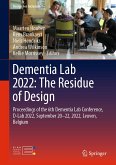Design for Dementia, Mental Health and Wellbeing (eBook, PDF)
Co-Design, Interventions and Policy
Redaktion: Niedderer, Kristina; Holthoff-Detto, Vjera; Dening, Tom; Ludden, Geke
37,95 €
37,95 €
inkl. MwSt.
Sofort per Download lieferbar

19 °P sammeln
37,95 €
Als Download kaufen

37,95 €
inkl. MwSt.
Sofort per Download lieferbar

19 °P sammeln
Jetzt verschenken
Alle Infos zum eBook verschenken
37,95 €
inkl. MwSt.
Sofort per Download lieferbar
Alle Infos zum eBook verschenken

19 °P sammeln
Design for Dementia, Mental Health and Wellbeing (eBook, PDF)
Co-Design, Interventions and Policy
Redaktion: Niedderer, Kristina; Holthoff-Detto, Vjera; Dening, Tom; Ludden, Geke
- Format: PDF
- Merkliste
- Auf die Merkliste
- Bewerten Bewerten
- Teilen
- Produkt teilen
- Produkterinnerung
- Produkterinnerung

Bitte loggen Sie sich zunächst in Ihr Kundenkonto ein oder registrieren Sie sich bei
bücher.de, um das eBook-Abo tolino select nutzen zu können.
Hier können Sie sich einloggen
Hier können Sie sich einloggen
Sie sind bereits eingeloggt. Klicken Sie auf 2. tolino select Abo, um fortzufahren.

Bitte loggen Sie sich zunächst in Ihr Kundenkonto ein oder registrieren Sie sich bei bücher.de, um das eBook-Abo tolino select nutzen zu können.
This edited volume reflects on how design can contribute to people's wellbeing and mental health in the context of dementia, mental illness and neurodiversity. It is an important resource for designers, researchers, students, policy providers and health and care professionals.
- Geräte: PC
- mit Kopierschutz
- eBook Hilfe
Andere Kunden interessierten sich auch für
![Design for Dementia, Mental Health and Wellbeing (eBook, ePUB) Design for Dementia, Mental Health and Wellbeing (eBook, ePUB)]() Design for Dementia, Mental Health and Wellbeing (eBook, ePUB)37,95 €
Design for Dementia, Mental Health and Wellbeing (eBook, ePUB)37,95 €![Transforming the Doctor's Office (eBook, PDF) Transforming the Doctor's Office (eBook, PDF)]() Ann Sloan DevlinTransforming the Doctor's Office (eBook, PDF)64,95 €
Ann Sloan DevlinTransforming the Doctor's Office (eBook, PDF)64,95 €![The Design, Implementation, and Audit of Occupational Health and Safety Management Systems (eBook, PDF) The Design, Implementation, and Audit of Occupational Health and Safety Management Systems (eBook, PDF)]() Ron C. McKinnonThe Design, Implementation, and Audit of Occupational Health and Safety Management Systems (eBook, PDF)52,95 €
Ron C. McKinnonThe Design, Implementation, and Audit of Occupational Health and Safety Management Systems (eBook, PDF)52,95 €![Creative Design and Innovation (eBook, PDF) Creative Design and Innovation (eBook, PDF)]() Robin RoyCreative Design and Innovation (eBook, PDF)38,95 €
Robin RoyCreative Design and Innovation (eBook, PDF)38,95 €![Design for Sport (eBook, PDF) Design for Sport (eBook, PDF)]() Anxo Cereijo RoibásDesign for Sport (eBook, PDF)57,95 €
Anxo Cereijo RoibásDesign for Sport (eBook, PDF)57,95 €![Danish Design Heritage and Global Sustainability (eBook, PDF) Danish Design Heritage and Global Sustainability (eBook, PDF)]() Ditte Lysgaard VindDanish Design Heritage and Global Sustainability (eBook, PDF)40,95 €
Ditte Lysgaard VindDanish Design Heritage and Global Sustainability (eBook, PDF)40,95 €![Dementia Lab 2022: The Residue of Design (eBook, PDF) Dementia Lab 2022: The Residue of Design (eBook, PDF)]() Dementia Lab 2022: The Residue of Design (eBook, PDF)113,95 €
Dementia Lab 2022: The Residue of Design (eBook, PDF)113,95 €-
-
-
This edited volume reflects on how design can contribute to people's wellbeing and mental health in the context of dementia, mental illness and neurodiversity. It is an important resource for designers, researchers, students, policy providers and health and care professionals.
Dieser Download kann aus rechtlichen Gründen nur mit Rechnungsadresse in A, B, BG, CY, CZ, D, DK, EW, E, FIN, F, GR, HR, H, IRL, I, LT, L, LR, M, NL, PL, P, R, S, SLO, SK ausgeliefert werden.
Produktdetails
- Produktdetails
- Verlag: Taylor & Francis eBooks
- Seitenzahl: 374
- Erscheinungstermin: 22. Juli 2024
- Englisch
- ISBN-13: 9781040023679
- Artikelnr.: 70886619
- Verlag: Taylor & Francis eBooks
- Seitenzahl: 374
- Erscheinungstermin: 22. Juli 2024
- Englisch
- ISBN-13: 9781040023679
- Artikelnr.: 70886619
- Herstellerkennzeichnung Die Herstellerinformationen sind derzeit nicht verfügbar.
Kristina Niedderer is Professor of Design at Manchester Metropolitan University, UK. Geke Ludden is Professor of Interaction Design at the University of Twente, the Netherlands. Tom Dening is Professor of Dementia Research in the School of Medicine, University of Nottingham, UK. Vjera Holthoff-Detto is Professor of Old Age Psychiatry at the Faculty of Medicine Carl Gustav Carus, Technische Universität Dresden, Germany.
1. Introduction: designing for wellbeing in the context of dementia, mental
illness and neurodiversity Part 1: Co-designing for wellbeing 2. A moral
compass for co-creation challenges involving experts by experience in
research and innovation projects in mental health and wellbeing in later
life 3. Co-design for sustainable youth mental health in Australia 4.
Spaces of co-design in mental health, neurology and neuroscience 5.
Co-design of eHealth in the context of severe mental illness 6. Guidelines
for facilitation: articulating tacit knowledge on co-designing within
mental health 7. Psychosocial design and engagement at The Big Anxiety
festivals 8. Designing community arts engagement for people with dementia
and their informal care partners Part 2: Design interventions 9. Designing
for dementia: examining design-led approaches and innovations 10. Reducing
anxiety with a HUG 11. DCare: empowering dementia caregivers in Indian
families in informal care settings 12. The adaptation of the dementia
village model: comparing design features of a Dutch and Canadian dementia
village 13. Evaluation of technologies and products for psychosocial
intervention and support for and with people living with dementia 14.
Identifying and categorising mindfulness-based design interventions to
support people with dementia and their wellbeing 15. Mindful design for
designers: the dimensions of socio-cognitive mindfulness and correlating
the Mindful Design Evaluation Scale and visual cards for expert use 16.
Compassionate technology, value-based design for (e-)mental health 17. We
want to play too: co-design of a public intergenerational play space and
service for improved mental health for older adults in the Australian
Capital Territory Part 3: Policy and design 18. Designing and influencing
mental health policy: bringing evidence and experience to decision-making
19. How can policymakers design for mental health and wellbeing? 20.
Developing culturally appropriate dementia interventions for people from
culturally diverse backgrounds 21. Design principles and guidelines for
inclusive mHealth design for people living with dementia 22. Flexibility
and customisation: starting from ASD to design sensory healthcare
environments for people's wellbeing 23. Sensory-friendly LED lighting for
healthcare environments: co-producing design regulations to meet autistic
needs 24. Conclusion: designing for a better life
illness and neurodiversity Part 1: Co-designing for wellbeing 2. A moral
compass for co-creation challenges involving experts by experience in
research and innovation projects in mental health and wellbeing in later
life 3. Co-design for sustainable youth mental health in Australia 4.
Spaces of co-design in mental health, neurology and neuroscience 5.
Co-design of eHealth in the context of severe mental illness 6. Guidelines
for facilitation: articulating tacit knowledge on co-designing within
mental health 7. Psychosocial design and engagement at The Big Anxiety
festivals 8. Designing community arts engagement for people with dementia
and their informal care partners Part 2: Design interventions 9. Designing
for dementia: examining design-led approaches and innovations 10. Reducing
anxiety with a HUG 11. DCare: empowering dementia caregivers in Indian
families in informal care settings 12. The adaptation of the dementia
village model: comparing design features of a Dutch and Canadian dementia
village 13. Evaluation of technologies and products for psychosocial
intervention and support for and with people living with dementia 14.
Identifying and categorising mindfulness-based design interventions to
support people with dementia and their wellbeing 15. Mindful design for
designers: the dimensions of socio-cognitive mindfulness and correlating
the Mindful Design Evaluation Scale and visual cards for expert use 16.
Compassionate technology, value-based design for (e-)mental health 17. We
want to play too: co-design of a public intergenerational play space and
service for improved mental health for older adults in the Australian
Capital Territory Part 3: Policy and design 18. Designing and influencing
mental health policy: bringing evidence and experience to decision-making
19. How can policymakers design for mental health and wellbeing? 20.
Developing culturally appropriate dementia interventions for people from
culturally diverse backgrounds 21. Design principles and guidelines for
inclusive mHealth design for people living with dementia 22. Flexibility
and customisation: starting from ASD to design sensory healthcare
environments for people's wellbeing 23. Sensory-friendly LED lighting for
healthcare environments: co-producing design regulations to meet autistic
needs 24. Conclusion: designing for a better life
1. Introduction: designing for wellbeing in the context of dementia, mental
illness and neurodiversity Part 1: Co-designing for wellbeing 2. A moral
compass for co-creation challenges involving experts by experience in
research and innovation projects in mental health and wellbeing in later
life 3. Co-design for sustainable youth mental health in Australia 4.
Spaces of co-design in mental health, neurology and neuroscience 5.
Co-design of eHealth in the context of severe mental illness 6. Guidelines
for facilitation: articulating tacit knowledge on co-designing within
mental health 7. Psychosocial design and engagement at The Big Anxiety
festivals 8. Designing community arts engagement for people with dementia
and their informal care partners Part 2: Design interventions 9. Designing
for dementia: examining design-led approaches and innovations 10. Reducing
anxiety with a HUG 11. DCare: empowering dementia caregivers in Indian
families in informal care settings 12. The adaptation of the dementia
village model: comparing design features of a Dutch and Canadian dementia
village 13. Evaluation of technologies and products for psychosocial
intervention and support for and with people living with dementia 14.
Identifying and categorising mindfulness-based design interventions to
support people with dementia and their wellbeing 15. Mindful design for
designers: the dimensions of socio-cognitive mindfulness and correlating
the Mindful Design Evaluation Scale and visual cards for expert use 16.
Compassionate technology, value-based design for (e-)mental health 17. We
want to play too: co-design of a public intergenerational play space and
service for improved mental health for older adults in the Australian
Capital Territory Part 3: Policy and design 18. Designing and influencing
mental health policy: bringing evidence and experience to decision-making
19. How can policymakers design for mental health and wellbeing? 20.
Developing culturally appropriate dementia interventions for people from
culturally diverse backgrounds 21. Design principles and guidelines for
inclusive mHealth design for people living with dementia 22. Flexibility
and customisation: starting from ASD to design sensory healthcare
environments for people's wellbeing 23. Sensory-friendly LED lighting for
healthcare environments: co-producing design regulations to meet autistic
needs 24. Conclusion: designing for a better life
illness and neurodiversity Part 1: Co-designing for wellbeing 2. A moral
compass for co-creation challenges involving experts by experience in
research and innovation projects in mental health and wellbeing in later
life 3. Co-design for sustainable youth mental health in Australia 4.
Spaces of co-design in mental health, neurology and neuroscience 5.
Co-design of eHealth in the context of severe mental illness 6. Guidelines
for facilitation: articulating tacit knowledge on co-designing within
mental health 7. Psychosocial design and engagement at The Big Anxiety
festivals 8. Designing community arts engagement for people with dementia
and their informal care partners Part 2: Design interventions 9. Designing
for dementia: examining design-led approaches and innovations 10. Reducing
anxiety with a HUG 11. DCare: empowering dementia caregivers in Indian
families in informal care settings 12. The adaptation of the dementia
village model: comparing design features of a Dutch and Canadian dementia
village 13. Evaluation of technologies and products for psychosocial
intervention and support for and with people living with dementia 14.
Identifying and categorising mindfulness-based design interventions to
support people with dementia and their wellbeing 15. Mindful design for
designers: the dimensions of socio-cognitive mindfulness and correlating
the Mindful Design Evaluation Scale and visual cards for expert use 16.
Compassionate technology, value-based design for (e-)mental health 17. We
want to play too: co-design of a public intergenerational play space and
service for improved mental health for older adults in the Australian
Capital Territory Part 3: Policy and design 18. Designing and influencing
mental health policy: bringing evidence and experience to decision-making
19. How can policymakers design for mental health and wellbeing? 20.
Developing culturally appropriate dementia interventions for people from
culturally diverse backgrounds 21. Design principles and guidelines for
inclusive mHealth design for people living with dementia 22. Flexibility
and customisation: starting from ASD to design sensory healthcare
environments for people's wellbeing 23. Sensory-friendly LED lighting for
healthcare environments: co-producing design regulations to meet autistic
needs 24. Conclusion: designing for a better life







